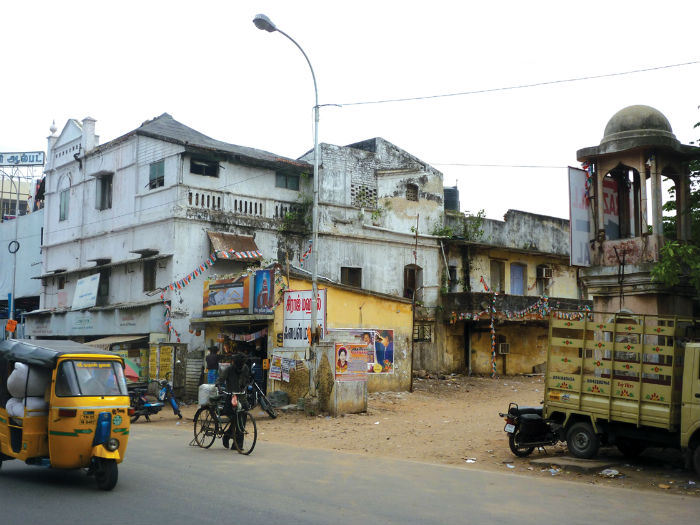Registered with the Registrar of Newspapers for India under R.N.I 53640/91
Vol. XXVIII No. 4, June 1-15, 2018
Lost Landmarks of Chennai
SRIRAM V
The ice makers we once had – 2
A plentitude of ice-makers
(Continued from last week)

Edinburgh House – home of South Indian Royal Ice Factory.
In 1859, we read of the Super-intendent of the Madras Ice House appealing to the public to increase their off take of the commodity. He requested greater demand as it was only backed by this could he build additional storage facilities at the Ice House. Till then, the availability of ice was dependent on the safe arrival of each ship bearing its load of American ice. The cost had recently doubled and the freight of one cargo amounted to Rs 11,000. By then however, it would appear that the locals had developed other means of making ice though details were not available.
By the mid 1866s, we read of companies being floated in Madras for making ice. The first of these appears to be the Madras Ice Company, established in 1865 with a high profile set of directors – Charles A. Ainslie of Binny, John Charles Loch of Parry and the barrister John Bruce Norton. Based on the profits made in similar companies in Bombay and Calcutta, the entity promised that a single year’s profit would exceed the capital of Rs 50,000. For all this tall projection there is no record of how it fared and we must assume that the project ended in failure.
By the 1870s, the Royal Navy showed that ice could be made using what was called the steam process. The International Ice Company was established in Madras in 1874. Nothing much is known about it. Also equally inchoate is the history of the Madras Ice Manufacturing Company, which ran at least between 1879 and 1882, with Frederick James Walker as its resident engineer and manager. In 1886, Subramania Pillai, of the firm of P. Vencatachellum’s, along with two other shareholders, began the South India Ice Factory located at 2, Poonamallee High Road, Periamet. Becoming sole proprietor in 1889, he modernised the facility. A new plant, capable of making 5 tonnes of ice a day, was imported from England. A storeroom for 80,000 pounds of ice was constructed, as was a cold storage. From 1895 to 1901, the plant was leased to Binny, which retailed the ice from a depot in Nungambakkam. When the lease ended, the company changed its name to P Vencatachellum’s Ice Factory, reflecting its connection with the world-famous brand name in curry powders and condiments. Ice from here was supplied to all the clubs, hotels, messes and hospitals.
Divisions in the Venkatachellum family saw the closure of their ice facility in 1920. A rival was the Crystal Ice Factory, Whannel’s Road, Egmore, run by W.B. Keene and John Ramsay Unger. Venkatachellum’s heyday was when Crystal went bust in 1904. But it revived in 1913, as the South Indian Royal Ice Factory (SIRIF), run by Unger. Legend has since persisted that he was Ramaswami Iyengar who converted but the Ungers were of Indo-Austrian origin, the first Unger serving as a gunner in the Madras Army. Later Ungers were civilians with John Ramsay Unger promoting Ramsay & Co, one of the contractors who built Ripon Buildings.
John’s son, S. Ramsay Unger, trained in refrigeration at Louisville, USA, ran the ice business. The Unger residence, Edinburgh House, was in the same compound. By 1916, the plant had a 7-tonne capacity. John Ramsay Unger died in 1929. The business expanded under his son and by 1946, included cold-storage facilities for fish, meat and fruit. The South Indian Railway Company, whose terminus was at Egmore Station, was a big customer. Indians would discretely visit Unger’s for alcoholic refreshments on the sly and that was good business too. Demand waned in the 1960s thanks to domestic and industrial refrigeration. Unger’s factory changed hands, closing thereafter due to erratic power supply. The Albert Theatre stands where its cooling tower was. But Edinburgh House survived till recently and its surrounding compound hosted several eateries, catering to the passengers of the railway, to which Unger once supplied ice. Work began on the demolition of the building a few months ago.
Coaeval to the SIRIF was the City Ice Manuacturing Company, located at 10, General Patters Road, Royapettah. Promoted by NK, II, HJ and JK Irani, its origins were due to HJ, who is also written of as JH in some accounts. As per actor Mohan V. Raman, JH came to Madras in 1931 and found the city perennially short of ice. He convinced his Poona-based family to set up business here and it prospered. By then, ice manufacture was more or less a Parsi monopoly across India. A theatre owner, also Parsi, got into ice manufacture and the Iranis felt this was violation of territory. They decided to get into film screening as a counter and leased the Star Theatre in Triplicane for a while. By then JH’s son Phiroze graduated from the College of Engineering Guindy and he was given the task of building a theatre. Thus it was that Casino on Blacker’s Road came to be built.
In 1938, Rustom F. Mazda set up the Mazda Ice Manufacturing Company. This came up on 14 grounds of land rented from the Society for the Prevention of Cruelty to Animals (SPCA). Business prospered till the 1990s according to the founder’s grandson Syrus, with “every pottikadai needing blocks of ice. Thereafter refrigerators became really widespread and offtake was restricted to fisherfolk from the Kasimedu harbour. Soon this too dwindled as ice units began coming up in their vicinity. We decided to close the factory in 2002 and return the land to the SPCA.”
With that ends the chronicle of the ice factories of Madras. It would be interesting to know how many large units now exist in and around the city.


Comments